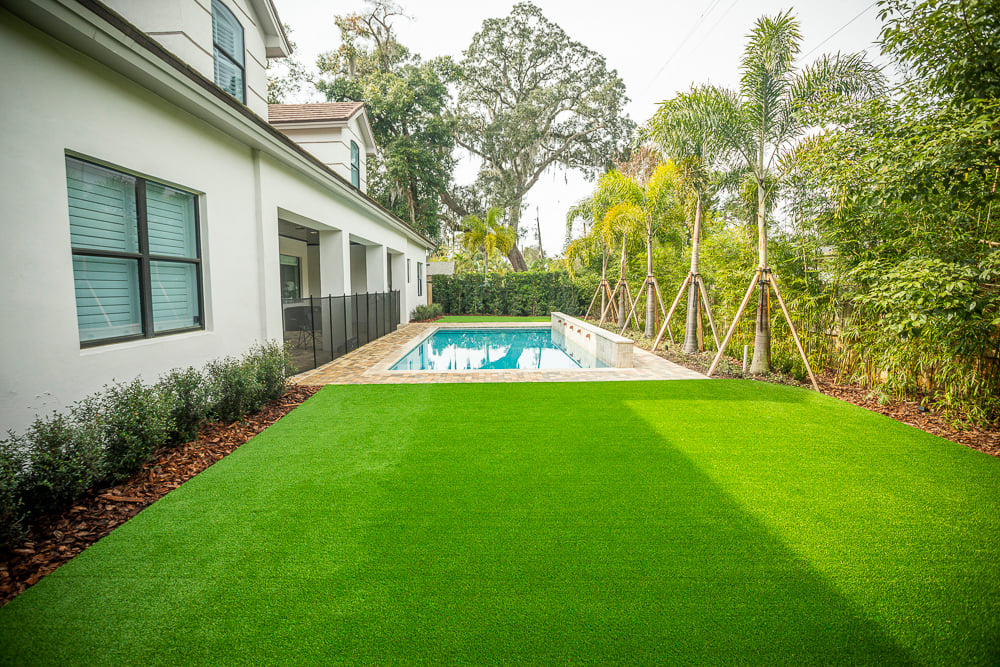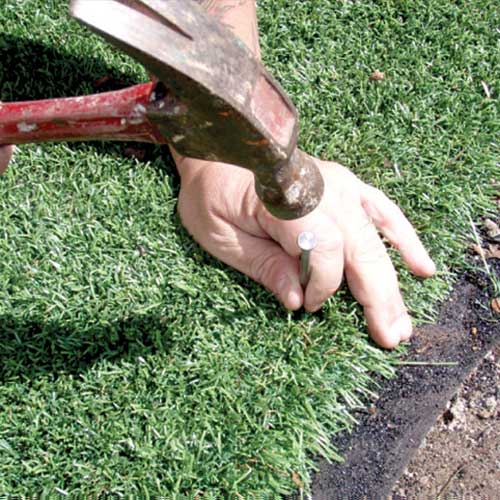Explore the Environmental Benefits of Opting for Synthetic Grass Solutions
The fostering of synthetic grass solutions offers a compelling chance to address pushing environmental challenges. By considerably reducing water usage and reducing the application of unsafe chemicals, these alternatives not only promote lasting landscaping yet also shield regional communities. The lower carbon footprint connected with lowered maintenance activities adds to a more sustainable approach to land monitoring. The effects of these benefits prolong past plain conservation initiatives, elevating questions about their long-term effect on environment conservation and total eco-friendly balance. Exploring these measurements reveals a complex interaction worth considering.
Water Conservation Benefits
One of the most substantial benefits of artificial lawn is its ability to preserve water. In comparison, artificial turf does not need watering, dramatically decreasing the general need for water resources.
By getting rid of the demand for routine watering, fabricated grass adds to sustainable landscape techniques and aids minimize the ecological effect of too much water usage. The preservation of water prolongs to the decrease of overflow, which can lead to soil erosion and river air pollution.
Additionally, the installment of fabricated turf permits districts and property owners to designate water resources extra efficiently, concentrating on important usages such as alcohol consumption water and agriculture. The shift towards synthetic grass not just advertises liable water usage yet also aligns with more comprehensive ecological objectives focused on protecting natural deposits.
As areas significantly focus on sustainability, the water preservation benefits of fabricated grass offer a compelling case for its fostering in household and commercial landscaping jobs.
Reduced Chemical Usage
The transition to artificial grass significantly decreases the dependence on chemical treatments commonly made use of in all-natural grass maintenance. Conventional lawn administration normally involves the application of chemicals, fertilizers, and herbicides to advertise growth and control parasites. These chemicals can present risks to human wellness, regional wildlife, and the atmosphere, adding to soil and water contamination.
In contrast, man-made lawn gets rid of the need for these damaging compounds. By minimizing the launch of artificial substances into the community, man-made lawn promotes healthier soil and water systems.
Furthermore, the absence of chemical drainage associated with synthetic grass installments helps secure regional rivers from contamination, supporting marine life and preserving biodiversity. Turf installation phoenix az. As areas increasingly prioritize sustainable practices, opting for man-made grass offers a feasible service that lines up with ecological preservation objectives. Through this change, homeowner can delight in rich environment-friendly spaces without endangering ecological wellness, paving the means for an extra lasting future
Lower Carbon Impact

In addition, the installment of artificial grass can lead to significant water preservation. Natural lawns call for significant amounts of water for irrigation, which not just includes in the carbon impact linked with water removal and therapy however also pressures neighborhood water sources. In contrast, synthetic grass requires marginal maintenance, calling for no watering, thereby significantly reducing water use and its connected power costs.
Furthermore, the durability of synthetic grass contributes to its reduced carbon influence. With a life expectancy of approximately 15 years or more, the demand for regular substitutes is decreased, resulting in less waste and reduced power usage in manufacturing and taking care of standard grass alternatives. In general, man-made turf presents a sustainable option for environmentally mindful landscape design.
Environment Conservation
Environment conservation is a crucial factor to consider in the argument over landscape design options, especially when contrasting synthetic grass to natural turf. Natural turf yards often call for extensive upkeep, consisting of the usage of chemicals, plant foods, and herbicides, which can negatively impact regional ecosystems. These chemicals can leach into the soil and waterways, hurting native flora and fauna and interfering with local habitats.
Man-made turf gets rid of the demand for hazardous chemicals, therefore protecting neighboring wild animals and keeping the honesty of bordering ecological communities. The setup of fabricated turf can lead to the conversion of former turf areas right into even more biodiverse landscapes, such as pollinator gardens or indigenous plant locations, which can support neighborhood wildlife.
Eventually, the change to fabricated turf not only conserves water and reduces maintenance initiatives however additionally cultivates a more unified connection between human tasks see here now and the natural surroundings, advertising environment conservation in the procedure.
Long-Term Sustainability
Long-term sustainability is a crucial consider examining the advantages of synthetic grass over standard grass lawns. One of one of the most considerable advantages of man-made grass is its longevity; it can last up to 15-20 years with very little maintenance, whereas all-natural lawn needs constant reseeding and substitute. This longevity decreases the requirement for constant resources, such as water, plant foods, and chemicals, which are important for keeping a healthy turf yard.
Furthermore, artificial turf adds he has a good point to a reduction in carbon discharges connected with lawn treatment devices. Standard yards typically require gas-powered mowers, leaners, and blowers, all of which add to air contamination. Arizona artificial turf. In contrast, man-made turf gets rid of the need for such devices, promoting a cleaner setting
In addition, the manufacturing of synthetic grass significantly uses recycled materials, enhancing its sustainability profile. As producers adopt environmentally friendly practices, the environmental impact of synthetic grass remains to reduce.

Final Thought
The fostering of synthetic lawn services offers substantial environmental benefits, consisting of considerable water preservation, decreased reliance on damaging chemicals, and a reduced carbon impact. Synthetic grass help in preserving natural habitats by minimizing land disruption and promoting long-lasting sustainability through the use of long lasting materials. Collectively, these variables underscore the potential of synthetic grass to add favorably to ecological health and supply a feasible choice to traditional landscaping practices in a significantly resource-conscious world.
In comparison, synthetic lawn does not require watering, significantly reducing the total demand for water sources. By decreasing the release of synthetic compounds into the community, artificial turf promotes healthier you can find out more dirt and water systems.
Additionally, the installment of fabricated turf can result in substantial water preservation. In comparison, man-made lawn needs marginal maintenance, requiring no watering, thus significantly decreasing water use and its associated energy costs.
